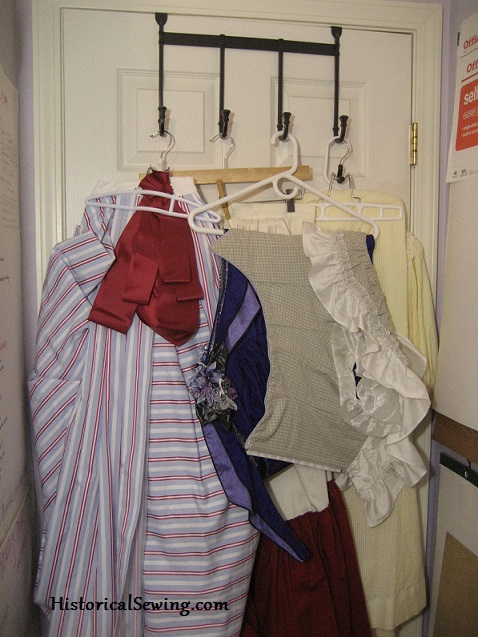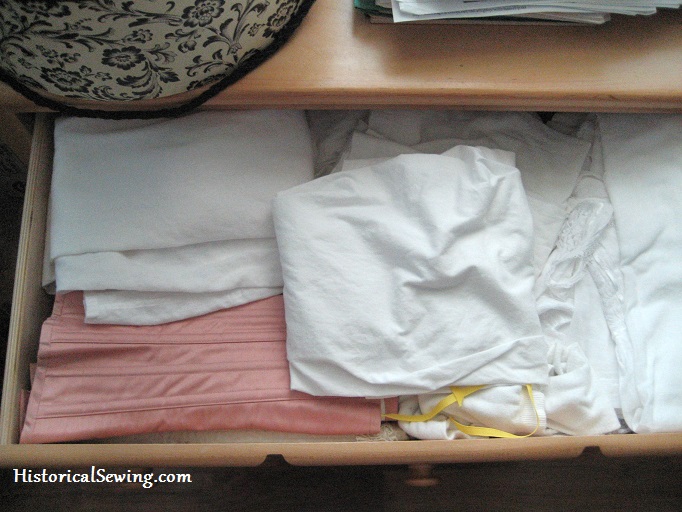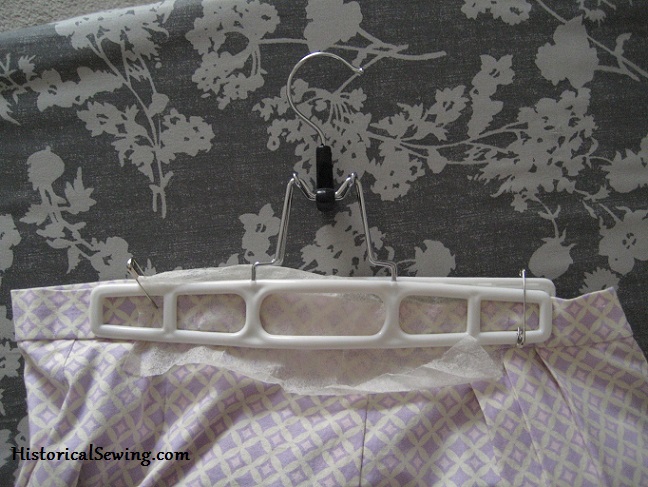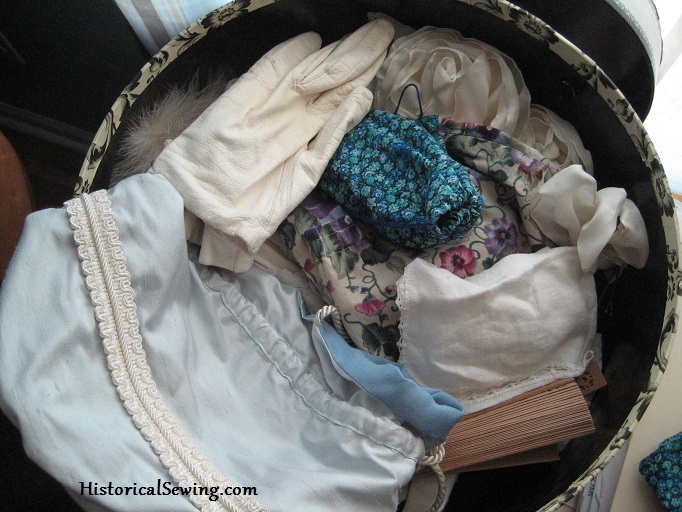
If you’ve been making costumes for any length of time you KNOW the space they take up in the house… the closets… the garage… the bathroom… under the bed… How does a flat bit of fabric suddenly need a stretch limo to take it home? Or its own bedroom to pout in?
And what happens when we get home from an event and pull off the sweaty, mangled mess that is our beautiful hard work? (I don’t know about you but I throw it on my cutting table and say “tomorrow is another day.”) Surely that crumpled thing needs cleaning and soon….
So what’s a costumer to do?
Here are 52 pointers gleaned from my own years of experience as well as some of those offered on our social media pages. Because, you know, eventually you’ll *have to* clean it and store it somewhere.
Disclaimer: This article is not about preserving antique or vintage garments as I am no antique textile expert. This article contains suggestions about how to clean and store those costumes you make from modern materials. If you want to preserve your costume projects for future generations, please consult with textile preservation authorities.
Cleaning
1. To wash or to dry clean? That is the question. …Well, really that’s the question we need to be asking BEFORE we sew up a garment. How you want to clean the final project is how you should think about pre-treating the fabric and trim that will go into it.
2. If you did not pre-treat the garment, dry cleaning is a good way to go after the event. But remember, harsh chemicals are used at the cleaners so keep this in mind when you have a particularly fragile costume.
3. When taking costumes to the dry cleaner give them instructions to DO NOT PRESS. You as the dressmaker know where every seam and every tuck and pleat is located and how it should appear in the garment. Dry cleaners are not versed in historical fashions. Do not leave your precious work to their modern sensibilities!
4. Wool garments can be machine washed but air drying (no heat when wet) is safest to prevent shrinkage. For best results when cleaning wool, spot clean with gentle cleanser or water then brush out.
5. Wash delicate cotton or linen dresses by hand in the tub or a wash bin.
6. Use the hand wash or delicate cycle on the machine for cotton and linen garments. Your undergarments, however, are meant to be washed over and over so a normal cycle in the machine is just fine.
7. Avoid harsh detergents if you plan to wash costumes often. Every wash weakens the fibers.
8. Spot cleaning was used often in the past, especially on elaborately trimmed gowns, and to prevent fabrics from wearing too quickly. Do the same with a bit of gentle cleanser like Woolite or basic liquid hand soap to work out bits of dust and grime. Use clean muslin to pad the top and bottom of the dirty area as you work out the stain.
9. Try Borax for an extra cleaning/whitening kick.
10. For extra special fabrics, use museum grade cleaners such as Ivory, Orvus, or Eucalan. (Find them at Lacis or Dharma Trading.)
11. Dry clean wool costumes. Although, it’s the heat of a clothes dryer that causes the most damage, so a gentle wash cycle on cold in the machine then laid flat to dry would work too.
12. Air-drying works very well for nearly all costumes. Wash by hand or machine and lay out to dry completely. Use a drying rack to support heavy, water laden cloth as it dries. Or lay out on towels remembering to rotate garments often and replace damp towels when necessary.
13. Avoid hanging wet garments as they can seriously stretch out on you.
14. Stockings, chemises, drawers, neck stocks, undersleeves, etc., can be washed on cold or warm in the washer and machine dried.
15. Place smaller articles in a lingerie bag when machine washing.
16. Use vodka to eat up odor causing bacteria in sweaty places such as under the arms and in the tight-fitting waist area. Forget the Stoli and go for the cheapest, store brand vodka on the bottom shelf. This is for cleaning, not consuming. Use full strength or water it down a bit (but not necessary).
Apply with a spray bottle and hit all those sweaty areas. Let it air dry. The smell evaporates quickly and your sweat stains should be relieved. Note: using vodka will only eat the bacteria that cause odors to form in the fabric. It will not actually clean your dress. For that you need soap and water or a dry cleaner.

Storage
Storing our costumes… ah, that issue that frustrates us all! With my own costumes I basically treat them as other, regular clothing. They hang in closets, are folded into drawers, and get mixed up with other modern articles.
17. Remember: Before storing it is quite necessary to make sure your costume pieces are completely dry. Actually, this is quite critical as any trapped moisture will attract mold spores and other unpleasantness.
18. Prevent fold lines by padding sleeves and other rounded areas of a costume with netting, quilt batting, or muslin.
19. Pad hangers too with bits of quilt batting covered with cotton scraps.
20. Don’t store costumes in the plastic dry cleaner bag. The bags are full of chemicals that can eventually destroy fabrics.
21. Use long garment bags and store only a couple costumes in each to prevent too much crush. Be aware of your costumes with trains and how that train gets placed into a garment bag. Let it hang as free as possible.
22. Wedding gown/bridal dress bags are a good choice as they are breathable but still protect from dust and insects.
23. Make long garment bags from thrift store twin or queen size sheets – fold in half long-ways and sew up the side. Add a drawstring casing around the top, and bottom if desired. Sew a long buttonhole in the two bottom ends to allow the bag to be folded in half and placed over the hanger hook.
24. If using a regular closet bar to hang costumes, throw an old sheet over the top of the bar and hangers to protect from dust.
25. Salvage old pillowcases by cutting a slit in the fold end (finish the raw edge with Fray Check or buttonhole stitches) and slipping over hangers.
26. Place items in portable trunks like cedar chests. Line with acid-free tissue or white cotton first to protect costumes from wood oils.
27. Use stackable plastic bins of all sizes for all your costume pieces. Arrange one costume with all it’s accessories per bin if you have room.

28. Use ordinary dresser drawers to store folded chemises, drawers, stockings and corsets. (You know, it’s your underwear drawer where you hide that photo of Mr Darcy!)
29. For corsets, gently fold in half or thirds and place flat in a drawer. Don’t tightly roll a corset for storage.
30. Another way to store corsets is placing them over a hanger with the threaded laces over the hanger bar. Drape several on one hanger then hang in the closet.
31. Utilize those shelves in the closet to store your hoops and bustles flat. (Elizabeth Bennet would be proud of you!) Hoops can also hang on hooks or be squeezed into thin spaces – as long as the wires don’t get bent you’re good.

32. For skirts, I love the tension hangers with the rubber on the inside and have used them for years. They seem to be getting harder to find but hold up heavy bustle skirts really well.
33. After you clasp the hanger over the garment or you secure with clips or clothespins, stab a safety pin through the garment and a space in the hanger for additional support.
34. Use wood hangers with clips to hang skirts. Add clothes pins in addition to the hanger clips for a minimum of 4 clips along each waistband.
35. Place strips of cotton or dryer sheets over skirt waistbands before securing to a hanger. This will reduce creases and lines along the garment where the clips are holding it.
36. For drawer storage, loosely roll skirts and petticoats – along seamlines if possible. Don’t squish too many skirts into a drawer at once or you’ll need to allow much ironing time before the next event.
37. Fold bodices gently in half or thirds, again as much on the seam lines as possible, and place in a drawer or box.
38. Drape evening bodices over a long hanger bar. You can stack several bodices this way to reduce closet space.
39. If your bodice and skirt is “small” enough, use a trouser/suit hanger and hang the skirt on the bar with clips then place the bodice on the hanger as you would normally.
40. Pull a Heidi and dress one hanger with two or three similar bodices to save space.

41. Use smaller decorative hat boxes to store all those little costume accessories like belts, fans, gloves and even jewelry bags.
42. Nest bonnets and hats inside each other to maximize space in one hat box. Place tissue or packing paper inside each headpiece to protect its shape.
43. Purchase the largest hat boxes you can find in attractive coverings to hold your hats and accessories and give you a home decorating item too. You can find them at craft stores such as Beverly’s, Michael’s, and Hobby Lobby, and at other outlet stores like Home Goods, Ross and Marshall’s.
44. Make quick cotton drawstring bags to hold shoes and accessories and hang them on the same hanger as the costume or place in the bottom of the garment bag.
45. If you want more secure, long-term storage of your costumes, arrange them in archival, acid free boxes – the largest size you can find & afford – wrapped with acid-free tissue paper. Don’t hang costumes but keep them flat and gently folded – as much along the seamlines as possible.
46. When storing in a cedar or other wood chest, line the area with clean, white cotton or acid-free tissue before filling with costume pieces.
47. Save silica gel packs from purse and shoe purchases to help absorb dampness in your costume storage area.
48. DO NOT USE moth balls. Instead use cedar chips or balls, but put them in cotton sachets to protect costumes from the wood oil.
49. If storing costumes in plastic bins and containers, leave the lid ajar for airflow.
50. Keep garment bags and storage boxes airtight when the bugs start coming out of the woodwork. But don’t keep them airtight for too long or condensation will build up attracting mold and other icky stuff!
51. Rotate costumes and refold them after a couple days of airing out if they’ve been in storage a long time.
52. If you have the space, rotate your costumes on a dressform display. Stuff the sleeves too. The form will keep the garment’s shape and you get to enjoy your hard work for a longer time.
Hopefully these tips have given you a few ideas of how to deal with your ever-growing costume collection.
What’s your favorite tip for cleaning and/or storing your costumes? Please share below!

How do I wash my items with pleated? Can they go in the wash machine.. Or do they need special care?
I generally don’t machine wash items with pleats. Dry cleaning is good. Or hand spot cleaning. If you do happen to machine wash, then you’ll most likely need to re-press the pleats (even if set with vinegar). If the back of the pleats are tacked then pressing after washing will be much easier. Again, I’d spot clean or dry clean them.
Thanks for the info… Would a home dry cleaning kit work… Like dryel?
Possibly. I’ve not used them but I’ve heard they work well.
Great advice! I would say try to stay away from using Safety Pins in storing your costumes if you live in a very humid area. The small amount of moisture can cause the pins to rust in my experience and create really awful stains.
For items stored in archival boxes, you should stuff the sleeves and bodice lightly, and put rolls of tissue along the folds (especially for the skirt). The idea is to prevent sharp folds anywhere, which are more prone to causing fiber breakage.
When a skirt hanger doesn’t grip tightly enough to hold a waistband, I find putting a salvaged shoulder pad inside the waistband provides enough extra bulk to allow a good hold.
Now if I could just solve the problem of my husband’s growing costume collection and its encroachment into my storage space.
Specifically for underarm sweat issues, use dress shields – or, ahem! ultra thin maxi pads with wings for a disposable alternative. They are usually thin enough not to interfere with the line of the bodice (a trick from when I used to dance professionally).
Have you read this article? https://historicalsewing.com/how-to-be-a-shield-maiden
I take hoops and store them flat on a hanger across the back of the closet. Regular clothes or costumes can be place on the regular rod 90 degrees from the hoops.
Warning about wedding dress bags- many are now all plastic and do not breathe. I still prefer making a muslin bag with a pocket on the inside for jewelry/accessories. 😉
May your needles never break,
Morigianna
Perk with a little boost added from Twin Pines is miraculous for cleaning any spot or stain on just about any fabric.
You are so very kind. A prodigiously useful article. I shall endeavour to acquaint my costuming friends with your wisdom.
I store my hoop skirts in a tutu bag. I used to store my platter tutus in it,but since I no longer dance for a ballet company, the bag has proved to be the perfect storage solution for hoops! I believe you can purchase them from discountdance.com or maybe even Amazon now.
NEVER use PVC when storing anything for more than a couple of days. This is what those dreaded drycleaning bags are made from. I’m certain you could find something better — strut hangers with the struts made of a cardboard tube might work.
My store sells several items listed, if anyone is interested. Wedding gown storage bags in NWPP (like the grocery store re-usable bags, breathable, cheap, travel well, unlike PVC, won’t off-gas & harm your costumes.) and Muslin for longer storage. We also sell padded hangers, padded with cotton batting and covered with muslin.
A trick I learned from working wardrobe on a movie- use babywipes (we used Chubbs) to remove makeup and grime, especially from white collars and cuffs. Instant dry clean!
Excellent suggestions and many of which I already employ…now if I only had larger closets and a few more dress forms/mannequins I could happily display more of my hard work. For now I’ll have to be happy with my three ( 2 females and one male). I do rotate my costumes with the seasons to keep my display interesting.
A lady who works for a museum gave me a great tip for storing dresses with trains! Make a train swing, this is made from a piece of PVC tube, say 40 cm long. Cover this with a soft material and lace a long ribbon thru the tube. Tie the ribbon around the hook of the hanger and determine how low the swing must hang, depending on the length of the train. Then throw train over swing, this way it won’t hang on the ground.
That’s a great idea!